Everything was in place for a memorable and devastating afternoon in Southeast Texas.
An Outbreak Unfolds
By 1:30 PM on November 21, 1992, the Southeast Texas tornado outbreak began. Wharton County took the hit first, with two F-1 tornadoes and one F-2 tornado near Wharton (there is some confusion about exactly what the tornado intensities were in Wharton County. The NOAA summary after the storm said 2 F-1’s and one F-2, while the Storm Data publication showed 3 F-1s). Fort Bend County was next where two F-1 tornadoes occurred at around 2:40 near and south of Sugar Land. But the most damaging was an F-2 tornado that touched down around 2:20 PM east of Fulshear and then moved into Cinco Ranch and Kelliwood and heavily damaged the West Houston Airport.
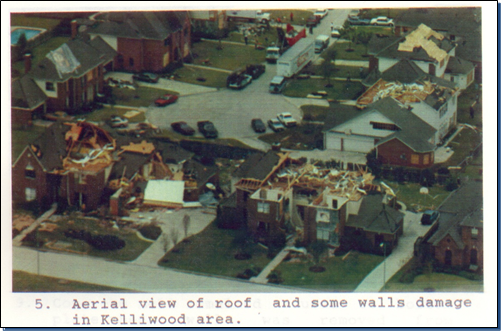
Things exploded as storms developed in Harris County, clashing with the moist air. An F-1 tornado developed north of Pearland and was reported as a funnel cloud at Hobby Airport at about 3:15 PM. About 5 to 10 minutes later, another tornado formed near Hermann Park and crossed the South Freeway (SH-288) into the Third Ward, then moved northeast into the East End, inflicting extensive damage north to Denver Harbor. That tornado was rated an F-2 and damaged over 600 homes and commercial buildings. Simultaneously, another tornado formed on the east side and touched down in Channelview. This tornado became the strongest in the region, evolving into a massive 0.75-to-1 mile-wide, F-4 intensity twister as it raked the Channelview area, damaging more than 1,200 homes and businesses and destroying many. The hardest hit area was the Sterling Green subdivision. The Channelview tornado weakened to F-2 intensity as it moved into Liberty County, dissipating near Dayton. As all this was going on, a third tornado developed in northeast Harris County. This one stayed on the ground for 32 miles into Liberty County before dissipating. It became an F-3 tornado that injured one and caused damage in Tarkington.
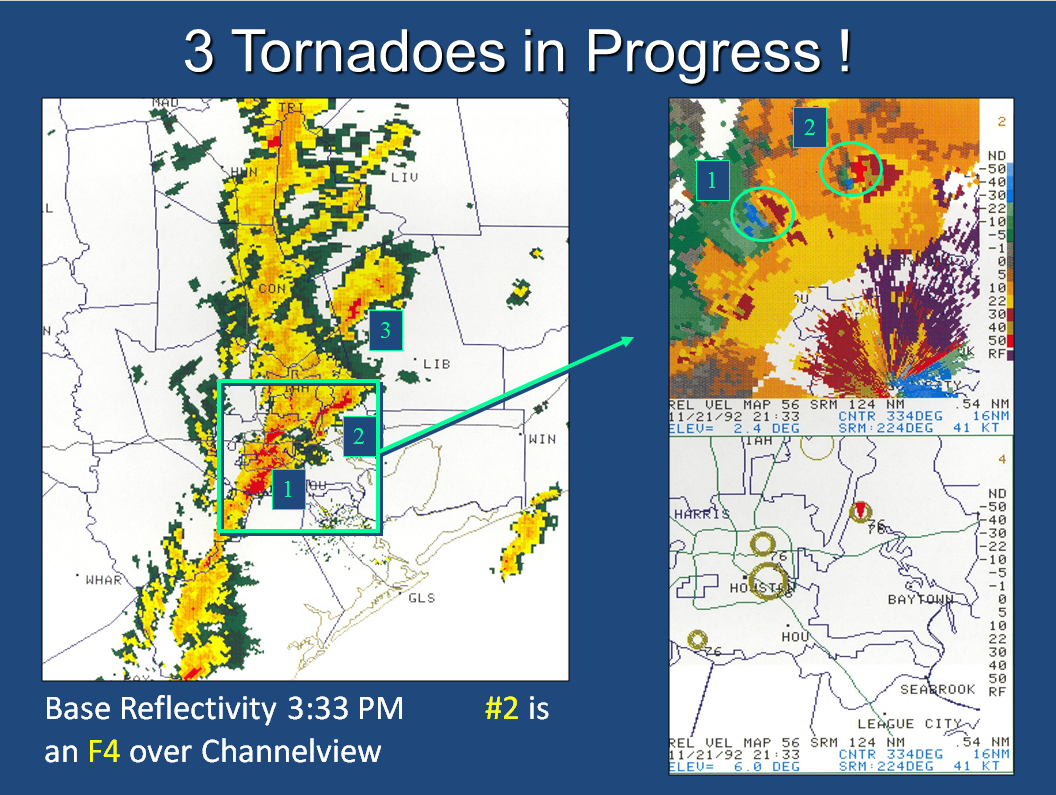
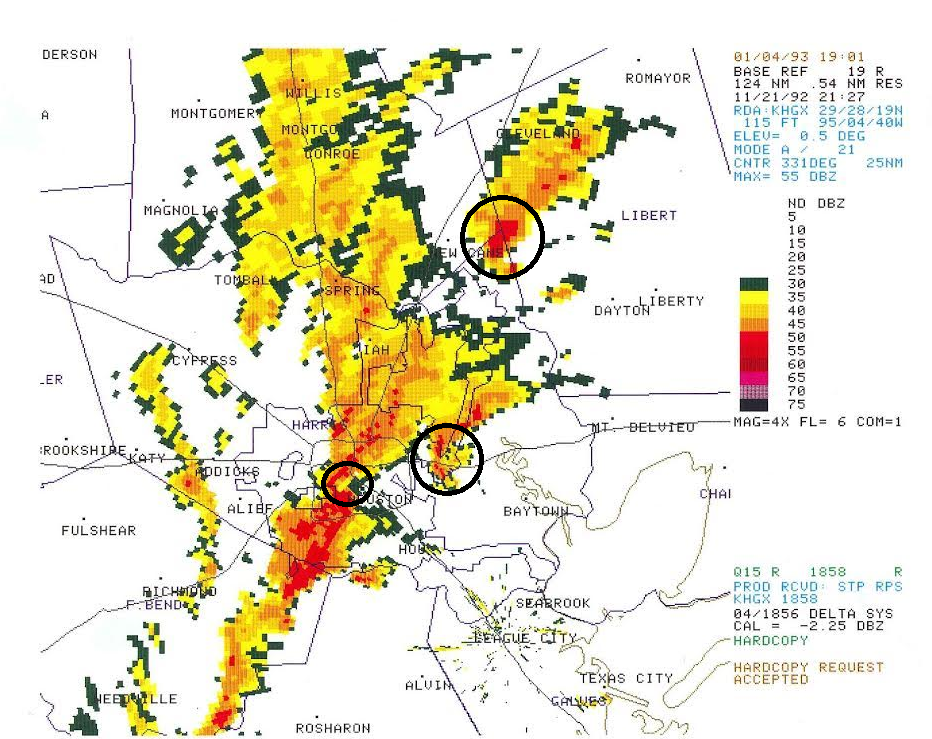
Let’s take a closer look at a couple of these twisters.
West Houston/Kelliwood Tornado
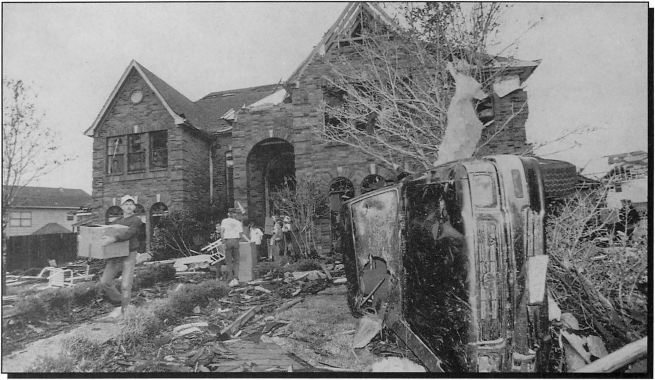
The F-2 tornado that hit west of Houston formed south of the Kelliwood subdivision, just west of George Bush Park. According to Marshall, who conducted damage surveys after the tornadoes, the Kelliwood storm tore off roofs, destroyed garages, and removed some exterior walls. The Houston Post reported that Natalie Kurz, an 11-year-old Kelliwood resident at the time, survived the tornado uninjured by hiding in a china closet under a stairwell in her home. Natalie had been playing upstairs when her mother, Debbie, saw the tornado and called her with instructions to hide. The Kurz’s lost part of their roof as the tornado damaged the room Natalie was in prior to her mother’s phone call.
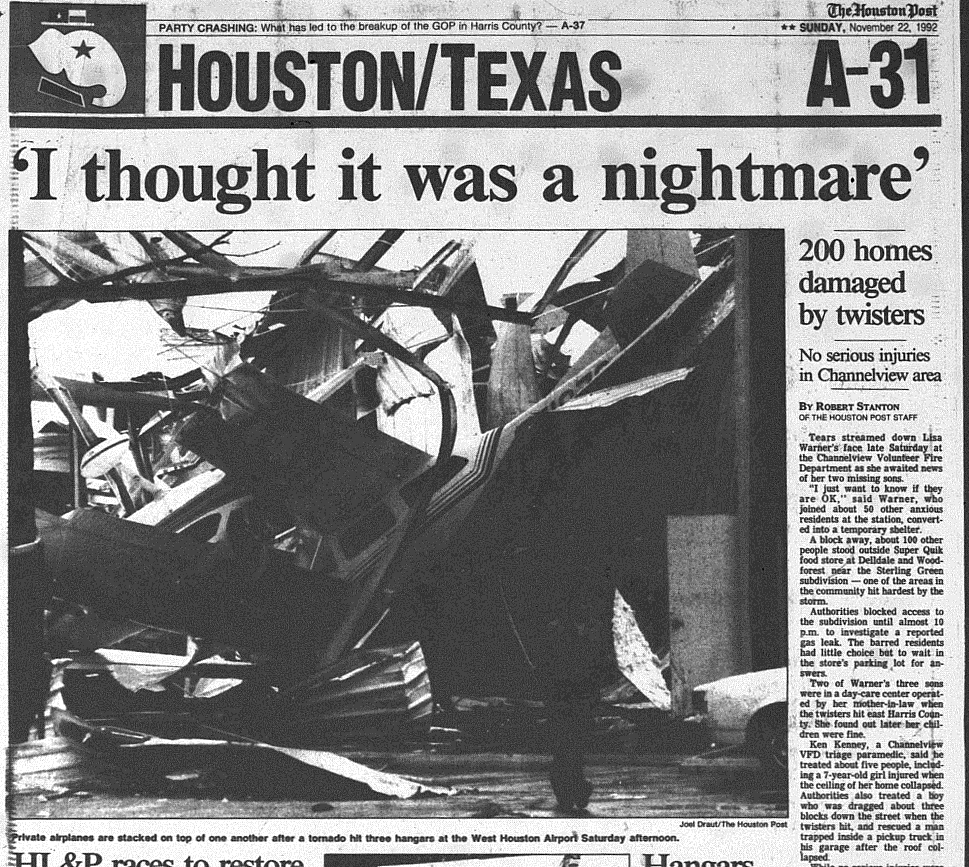
As the tornado crossed I-10, F-1 intensity damage was found. Several metal hangars at West Houston Airport were destroyed. Rob Baron, a flight instructor at West Houston Airport at the time, said that upwards of 23 private airplanes were damaged or destroyed by that tornado. According to Baron’s account in the Houston Post, around 30 people at the airport huddled inside the main hangar terminal as the tornado hit. Fortunately it survived and no one was injured.
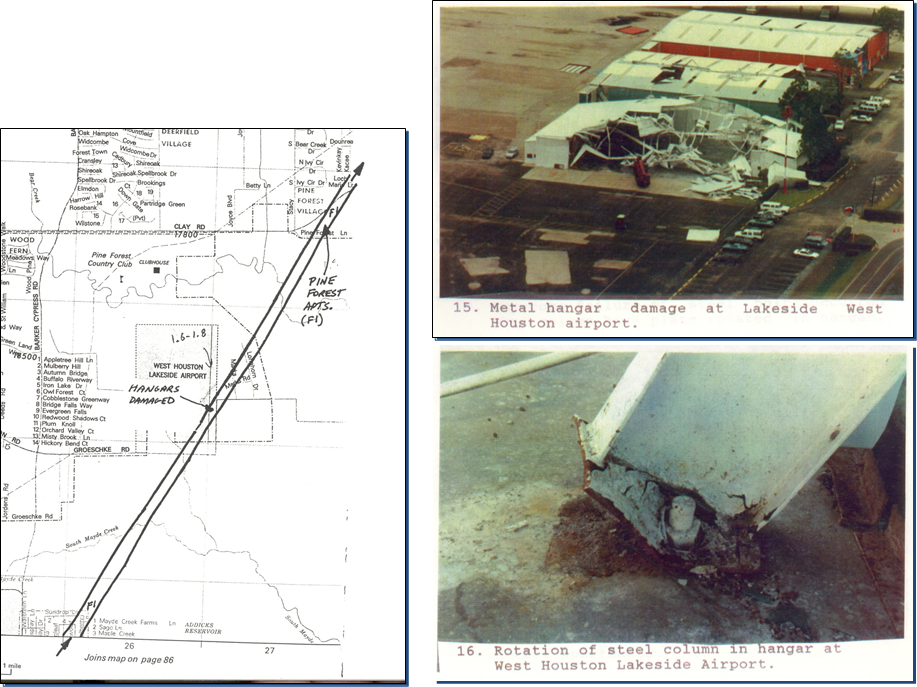
The tornado continued northeast into Bear Creek and damaged several homes and apartment complexes. Damage also occurred at a Randall’s at West Road and Jones Road in Northwest Houston, with windows blown out, cars damaged, and part of the roof blown off. This tornado was ultimately on the ground for nearly 20 miles before it dissipated.
East Side/Denver Harbor Tornado
Damage from the Inner Loop tornado began at the southeast edge of Hermann Park. As that tornado lifted north and east, it injured six, damaged over 600 homes and businesses, and likely contributed to a natural gas explosion just east of the junction of the South Freeway and US-59.
https://www.youtube.com/watch?v=KBNXWOl9isc
This tornado was on the ground for about 11-12 miles, inflicting some of its worst damage on some of the city’s most vulnerable residents east of downtown and in Denver Harbor. Ben Reyes, the City Councilman at the time whose district took the brunt of the damage from this storm said “The people who got hit the worst are the poorest people in my neighborhood.”
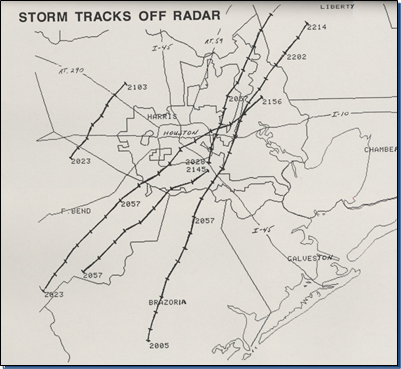
As in many instances of this event, the fact that more people were not seriously injured or even killed is almost a miracle. It seems many residents realized this. One victim was quoted in Monday, November 24th’s Houston Post as saying, “I feel all right. We just don’t have an apartment. Other than that, I’m glad no one got hurt.”
Another resident was injured, picked up and carried about 10 feet during the tornado while he was at a car repair shop on Navigation. Unfortunately he was there to check on a car that was being worked on, and both that vehicle and the other vehicle he drove over in were damaged.
The Denver Harbor tornado was classified as producing F-2 damage.
Channelview: Worst of the outbreak
Without question, the most severe tornado of the outbreak occurred in Channelview, just east of the city. The same storm that produced a weaker F-1 intensity tornado in Brazoria County, near Pearland around 3:10 PM, produced the monster F-4 tornado in Channelview about 15 minutes later.
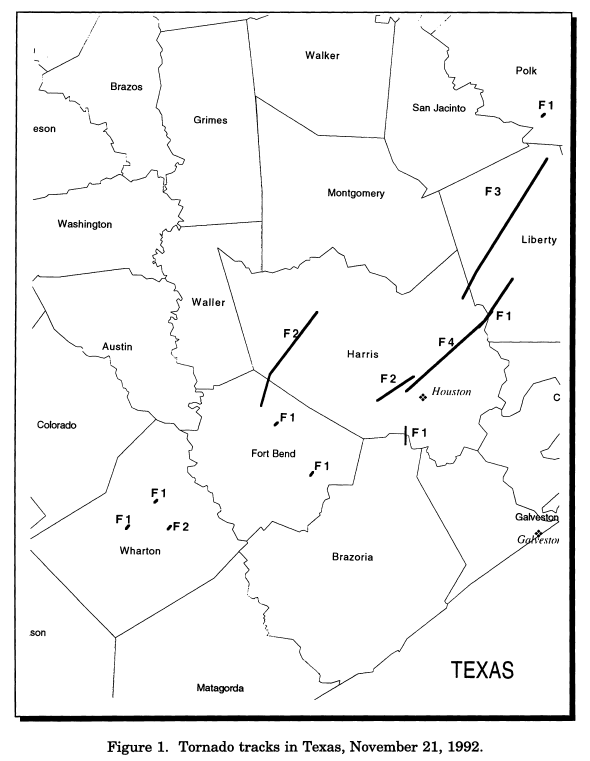
Per Tim Marshall’s damage survey, the Channelview twister formed near the Houston Ship Channel and lifted northeast, rapidly intensifying as it crossed I-10 and went on to ravage the Sterling Green subdivision. The damage was massive, and reporting at the time commonly compared the destruction in Channelview to that inflicted by Hurricane Andrew in South Florida three months earlier. Marshall’s survey found 183 homes that lost roof structures, 88 homes that had just a few interior walls left standing, and 14 homes with no interior walls left at all, indicative of F-4 damage. Marshall’s comments on patterns of damage is worth a read.
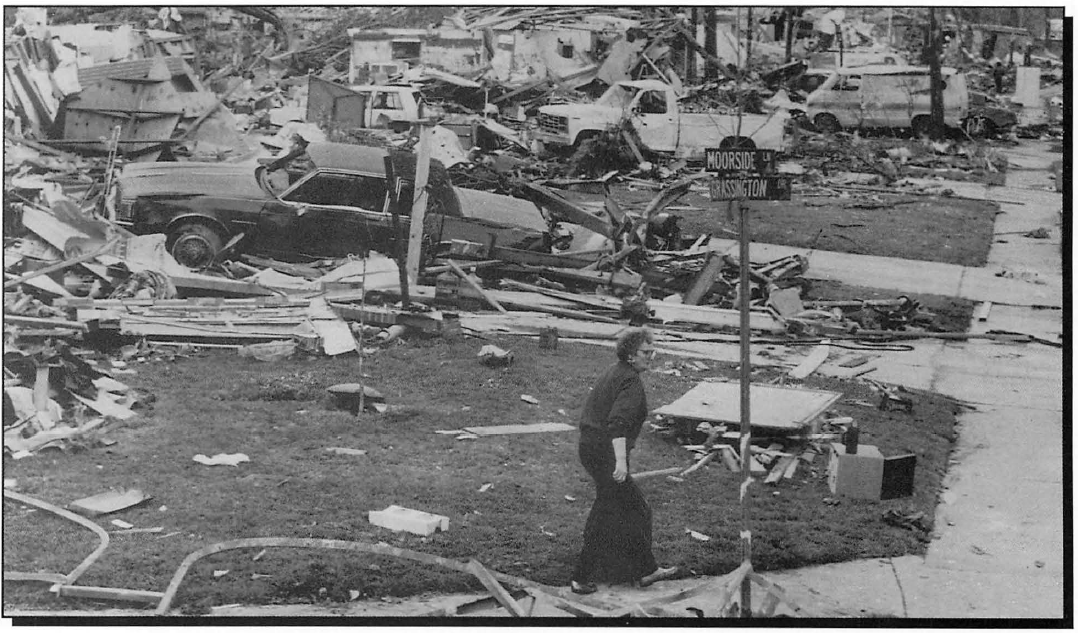
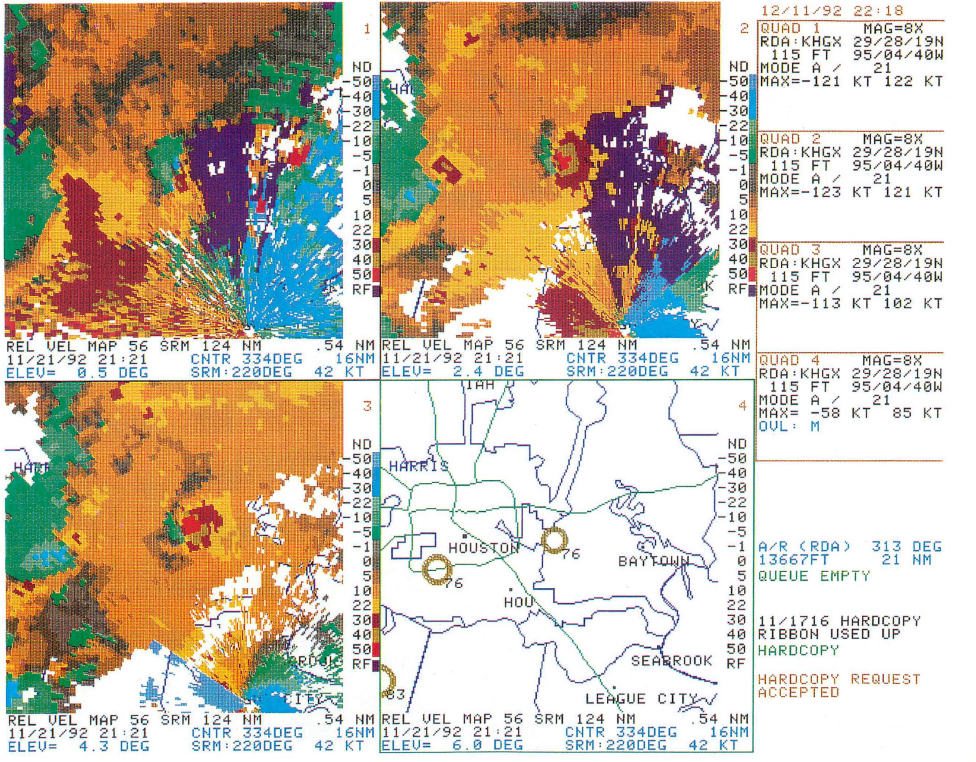
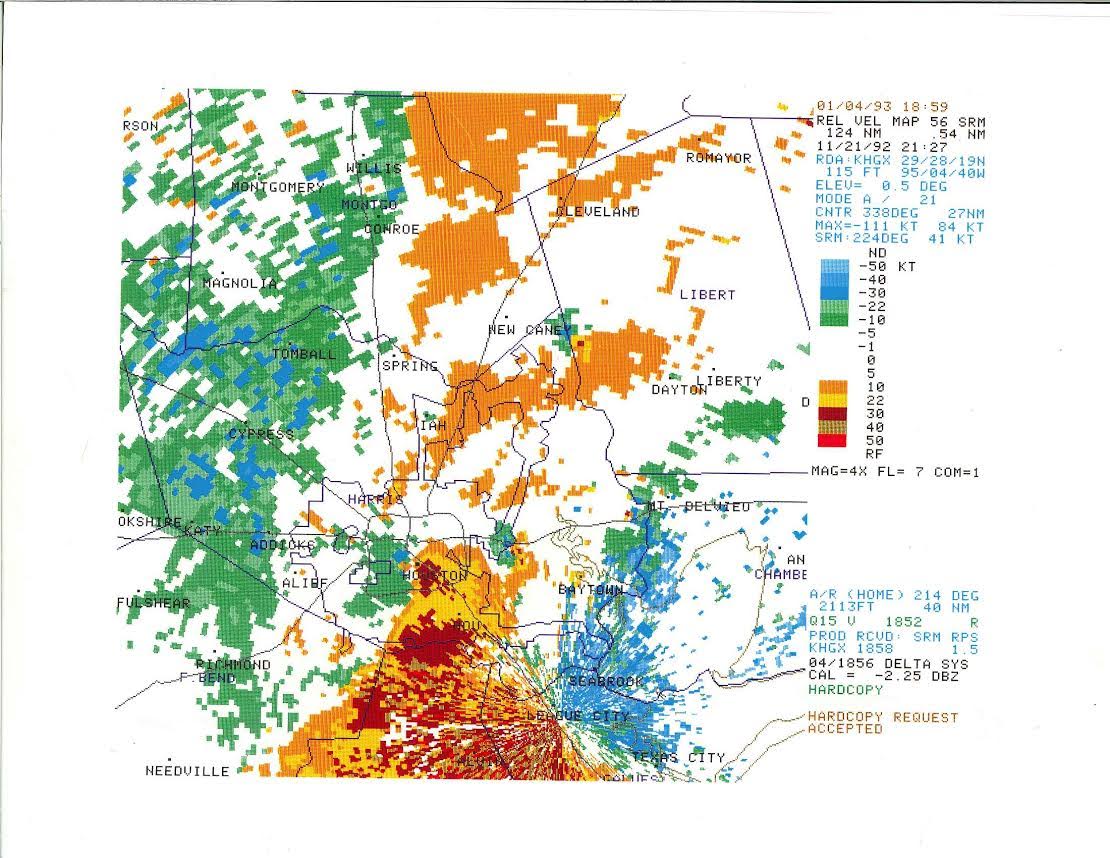
Reading the harrowing accounts of the Channelview tornado underscores how much good luck occurred that day.
(Post continues on next page)
My wife and I will always remember that day! We were married at St. Paul’s UMC on that blustery Saturday. Celebrating our 24th anniversary today.
Happy anniversary! Quite a memorable day for many reasons!
Brings back memories that had been filed away. Yet another reason for reliving these events. Not only for new residents for obvious reasons, but also for longer time residents as well. Certainly not sensationalism, but a gentle poke that things do happen and what we can do to raise our odds of survival.
Though not directly personally affected, I was a public school teacher of a sixth grade campus that served Pecan Grove at the time. The damage to a Randall’s grocery store (Jones Rd and West; now an HEB) was within a mile of the homestead.
Excellent job of reporting. Looking forward to future installments.
Thanks Timothy!
I was just a 13-year-old middle school kid from Sterling Green South in Channelview when this happened (ironically, we were nearer the Kelliwood tornadoes — shopping far from home at West Oaks Mall — when we first learned about what was going on), but I credit the entire experience — and especially helping many of our fellow church members with damaged and destroyed homes in the Sterling Green subdivision — with developing my interest in weather that now makes me appreciate this blog so much.
Thanks for sharing your story (and for the compliments), Justin! Had to be quite an experience.
I am looking forward to future articles in your retrospective series.
In ’92 I was a student at Rice working late in the library on the Saturday before Thanksgiving. I remember it was around 3PM and I looked east from the 3rd floor lounge and saw the blackest sky I have ever seen before or since, moving west. Decided to get out and go home before I might be stuck in thunderstorms.
There wasn’t much weather on my way home, just some rain and wind. However later that day and for the next week the media were full or reports of the local tornadoes that had hit so severely just before the holiday.
PS I remember this also because there was really no forewarning. I was a weather radio fan at the time and recall it was strange that there was no NWS warning for what seemed to be such bad weather coming in. For a few years afterward, local radio and tv went overboard and exaggerated almost any threat of bad weather. That’s how I remember it. Took them years to shake this habit and now we have in my opinion situations in which the media either exaggerate the danger, or overlook it almost completely.
Thanks for sharing your story!
It’s interesting, as the post-storm analysis really commended the NWS for adequate warnings and good lead time (actually, amazingly good for the early 90s). I wonder why that happened. Maybe there was a transmitter issue…will have to go back and see.
I, too, was a Rice student at that time. I remember that we were playing Navy that afternoon, and if Rice won, we would have our first winning football season in who knows how many years. The game was paused in the third quarter while the tornadoes passed by, but it was not cancelled. Morning heat gave way to a wet, cold afternoon. [I learned to recognize that pattern, but at that time I had been living in Houston for about three months.] The field was drenched, as was the audience. Both the MOB and the Navy band moved undercover during the pause, and they played impromptu concerts until the game resumed. The atmosphere at Rice Stadium was festive and unworried.I knew that windows were blown out downtown, but I had no idea of the widespread severity of damage until much later.
Rice did beat Navy that afternoon.
Thanks for sharing with us! Interesting to hear people’s perspectives years later.
Thank you for this well-researched and informative article. Fascinating – and a good reminder not to let our guards down when it comes to severe storms.
I very much appreciate the research and reporting that went into this story & look forward to more retrospectives on Houston’s wild weather.
Thanks so much, Sharon!
I truly enjoyed reading this.
I’ve always remembered the TV images of the planes flipped upside down at the West Houston airport.
That was my gold Jeep Cherokee on the front page. If I am not mistaken that same pic was on USA Today as well.
I ran next door and called 911 at Little Ceasars.
Me and many of my friends were working sacking at Randall’s. It was a extremely busy Thanksgiving shopping day.
Thanks for sharing your story, Chris. Incredible stuff!
That’s me in the middle of the front page. I was working the checkout right in front of the entry. I had just gotten to work and to my register, and I remember the sky was clear on my drive in.
After the store was hit and all the emergency crews got there, I remember they made us all go back into the freezer because another one was forming.
We lived on the corner of South Silver Green and MacClesby when this storm hit. We heard warnings for Wharton and Waller County, but that seemed so far away. I remember looking out the window and wondering what all the fuss was about because it was barely sprinkling and no wind. Then I saw a small dark wispy cloud (like a puff of smoke) just over the rooftops, moving really fast. I called my husband to the window so he could see the strange cloud and as soon as he got to the window, we saw the transformers blowing up behind us in Sterling Green South. That’s when we saw the tornado – we raised the living room window where we stood, grabbed the 2 dogs and made it almost to the hall before the windows started blowing out. Our garage was ripped off the house, nothing left but a pile of bricks and the roof was lifted and set back down crooked. Our washer and dryer ended up in the middle of the street and someone’s mattress was tangled in our tree. Our neighbor had a 2×4 stuck in the engine of his truck and we found clothes that didn’t belong to us in the living room. We couldn’t eat much for 2 days because our throats were so swollen from all the insulation we breathed. The Salvation Army served breakfast in our backyard for a couple days afterwards and the news stations set-up next to the house. Until I read this article, I didn’t realize we were dead-center of the path. Gave me chills, remembering. To this day I still don’t understand why it wasn’t raining or the wind wasn’t blowing – it was just an overcast afternoon.
Thanks for sharing your story. I was wondering if we’d hear some first-hand accounts from readers on this eventually. Really incredible. I’m glad you were able to escape without being too seriously hurt.
Small world. Remembering this on the 25th anniversary. I happened to be at a friend’s house in the 1400 block of Macclesby when the tornado hit. We lived around the corner on Rockington Ln. Was a crazy experience. I remember running home after in the rain to check on my parents and sister. Luckily, they hid in the restroom and survived. The house, not so much. The tornado took the whole roof off the house and the garage caved in. Never forget that day.